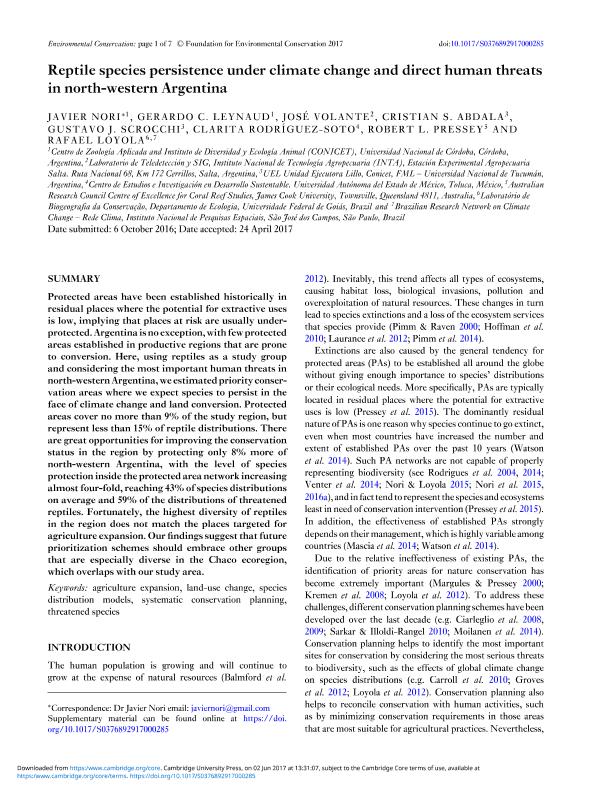Artículo
Reptile species persistence under climate change and direct human threats in north-western Argentina
Nori, Javier ; Leynaud, Gerardo Cristhian
; Leynaud, Gerardo Cristhian ; Volante, José Norberto; Abdala, Cristian Simón
; Volante, José Norberto; Abdala, Cristian Simón ; Scrocchi Manfrini, Gustavo Jose
; Scrocchi Manfrini, Gustavo Jose ; Rodríguez-Soto, Clarita; Pressey, Robert L.; Loyola, Rafael
; Rodríguez-Soto, Clarita; Pressey, Robert L.; Loyola, Rafael
 ; Leynaud, Gerardo Cristhian
; Leynaud, Gerardo Cristhian ; Volante, José Norberto; Abdala, Cristian Simón
; Volante, José Norberto; Abdala, Cristian Simón ; Scrocchi Manfrini, Gustavo Jose
; Scrocchi Manfrini, Gustavo Jose ; Rodríguez-Soto, Clarita; Pressey, Robert L.; Loyola, Rafael
; Rodríguez-Soto, Clarita; Pressey, Robert L.; Loyola, Rafael
Fecha de publicación:
03/2018
Editorial:
Cambridge University Press
Revista:
Environmental Conservation
ISSN:
0376-8929
e-ISSN:
1469-4387
Idioma:
Inglés
Tipo de recurso:
Artículo publicado
Clasificación temática:
Resumen
Protected areas have been established historically in residual places where the potential for extractive uses is low, implying that places at risk are usually under-protected. Argentina is no exception, with few protected areas established in productive regions that are prone to conversion. Here, using reptiles as a study group and considering the most important human threats in north-western Argentina, we estimated priority conservation areas where we expect species to persist in the face of climate change and land conversion. Protected areas cover no more than 9% of the study region, but represent less than 15% of reptile distributions. There are great opportunities for improving the conservation status in the region by protecting only 8% more of north-western Argentina, with the level of species protection inside the protected area network increasing almost four-fold, reaching 43% of species distributions on average and 59% of the distributions of threatened reptiles. Fortunately, the highest diversity of reptiles in the region does not match the places targeted for agriculture expansion. Our findings suggest that future prioritization schemes should embrace other groups that are especially diverse in the Chaco ecoregion, which overlaps with our study area.
Archivos asociados
Licencia
Identificadores
Colecciones
Articulos(IDEA)
Articulos de INSTITUTO DE DIVERSIDAD Y ECOLOGIA ANIMAL
Articulos de INSTITUTO DE DIVERSIDAD Y ECOLOGIA ANIMAL
Articulos(UEL)
Articulos de UNIDAD EJECUTORA LILLO
Articulos de UNIDAD EJECUTORA LILLO
Citación
Nori, Javier; Leynaud, Gerardo Cristhian; Volante, José Norberto; Abdala, Cristian Simón; Scrocchi Manfrini, Gustavo Jose; et al.; Reptile species persistence under climate change and direct human threats in north-western Argentina; Cambridge University Press; Environmental Conservation; 45; 1; 3-2018; 83-89
Compartir
Altmétricas



